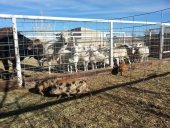








Shenanigans of the sheep and wooly sort.. And many more.. https://www.instagram.com/girlwalkswithgoats/
Papa always says, "Don't go away angry... just go away."








Shenanigans of the sheep and wooly sort.. And many more.. https://www.instagram.com/girlwalkswithgoats/
Papa always says, "Don't go away angry... just go away."






















 1
1




http://www.turkishbozshepherds.com
http://www.kunepigs.com/








Jay Hayes wrote:I've only self butchered 4 hogs, but my first experience using a light caliber gun made me a believer in the old timer stories about being chased around the barn by a hog you had just shot in the head. I have switched to using a 30-30 deer rifle at close range.
j
http://www.turkishbozshepherds.com
http://www.kunepigs.com/








Jenn Andersen at Sundog Ranch
www.SundogRanch.blogspot.com




Jenn Andersen wrote:I just want to clarify the everyone here is talking about at .22 rifle, right?
http://www.turkishbozshepherds.com
http://www.kunepigs.com/




 2
2
















Armin Voigt wrote:Sue,
Here is a link on where to find lead free 22 mag ammo.
http://www.cci-ammunition.com/products/detail.aspx?use=1&loadNo=0060

|
I've got no option but to sell you all for scientific experiments. Or a tiny ad:
Freaky Cheap Heat - 2 hour movie - HD streaming
https://permies.com/wiki/238453/Freaky-Cheap-Heat-hour-movie
|









